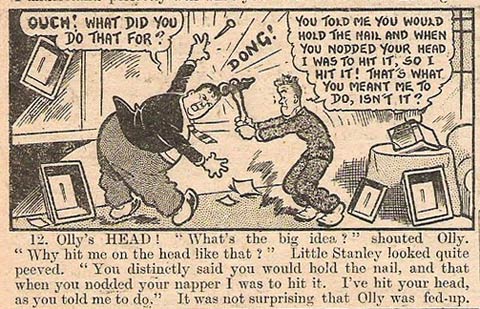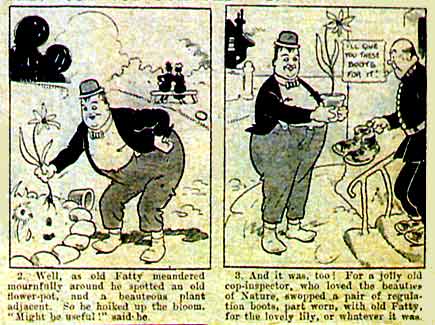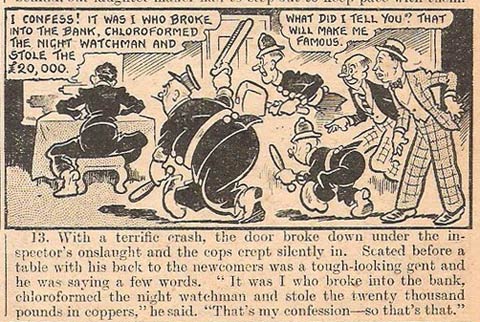'Laurel & Hardy' (Film Fun 24 September 1938).
George William Wakefield was an artist who worked extensively for the Amalgamated Press, and their comic book Film Fun in particular. Born in Hoxton, London, he dropped out of school in 1903 and won a scholarship to the Camberwell School of Arts and Crafts. He submitted his first cartoons to Ally Sloper's Half Holiday in 1906, while also earning some money as a boxer. He began an association with James Henderson papers like Scraps in the following year. One of the earliest strips he worked on was 'Baron De Cuff and the Honorable Samuel Shiney' for The Comic Companion.
'Laurel & Hardy' (Film Fun 24 September 1938).
Wakefield's first work for the Amalgamated Press appeared in titles like Fun & Fiction ('Gertie Goodson') and The Favorite Comic ('Flossie and Phyllis') in the early 1910s. He also contributed to The Penny Wonder and The Boys' Friend before serving in the Sixth City of London Regiment during World War I.
Afterwards his work was published weekly in Merry & Bright, where Wakefield first showed his talent for drawing famous personalities. At Film Fun he secured his reputation as one of the master penmen of the Golden Age. From 1920 on he drew most of the great stars of the day for this film weekly, from Ben Turpin, Jackie Coogan, Laurel and Hardy, Joe E, Brown, Wheeler & Woolsey to Max Miller, George Formby, Lupino Lane and many more. Especially his front page 'Laurel & Hardy' comics stood out.
'George Formby' (Film Fun, 24 September 1938).
Wakefield was also present in Film Fun's companion The Kinema Kid with features like 'The Funniosities of Fatty Arbuckle' and 'The Screen Screams of Ford Sterling', as well as other titles like Film Picture Stories, The Bullseye and The Surprise. Wakefield's drew the famous sports personalities of the day for Sports Fun (1922) and additionally made 'The Jolly Rover' for the front page of My Favourite and 'Freddie Flip and Uncle Bunkle' for Sparkler. Typical of Wakefield's work were the sketchy, simplified backgrounds and the unchanging angle of view.
Bill Wakefield continued to draw comics until the very end. In 1942 he was working on a set of 'Abbott & Costello' comics when he had a stroke and died at age 54. Several of his Film Fun features were continued by other artists, most notably his son Terence Wakefield, who, after returning from military service in 1946, started to draw 'Laurel & Hardy' comics.
George Wakefield was an influence on Leo Baxendale.
'Laurel & Hardy'.





